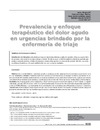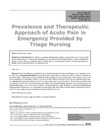Identificador persistente para citar o vincular este elemento:
https://accedacris.ulpgc.es/jspui/handle/10553/59993
| Título: | Prevalencia y enfoque terapéutico del dolor agudo en Urgencias brindado por la enfermería de triaje | Otros títulos: | Prevalence and therapeutic approach of acute pain in emergency provided by triage nursing Prevalência e abordagem terapêutica da dor aguda em pronto-socorro oferecidas pela enfermagem de triagem |
Autores/as: | Perera Gil, Jonay López Muñoz, Francisco Candelas Ocejo, Rosa María Chacón Ferrera, Rodrigo Morizot, Gloria |
Clasificación UNESCO: | 32 Ciencias médicas | Palabras clave: | Triaje Protocolos Enfermería Emergencias Urgencias médicas, et al. |
Fecha de publicación: | 2019 | Publicación seriada: | Aquichan | Resumen: | Objective: This work sought to assess the effectiveness of the treatment applied in patients with acute pain in the emergency service by triage nursing. Materials and Methods: Cross-sectional, observational descriptive study of quantitative approach, with measures of central tendency in 348 patients, conducted in 2016. An ad hoc questionnaire was used, elaborated by the emergency service, which assesses the intensity of pain through a numerical scale and a pain intervention protocol that includes physical and pharmacological measures. Results: After applying the first treatment, 80.17 % of the patients experienced improvement; 7.18 % required a second treatment and, of these, 87.5 % improved and 12.5 % suffered no modifications. The nursing staff treated the patients according to the protocol, with AINES and Metamizole, primarily. The rest were remitted to medical evaluation and another 40 patients rejected treatment. Conclusions: A high percentage of patients exist who improve their perception of pain after the first treatment administered by the triage nursing personnel. The results suggest revising and updating the protocol in the first treatment. Objetivo: valorar la efectividad del tratamiento aplicado en pacientes con dolor agudo en el servicio de urgencias por la enfermería de triaje. Materiales y métodos: estudio descriptivo observacional, de corte transversal y de abordaje cuantitativo, con medidas de tendencia central en 348 pacientes, realizado en 2016. Se utilizó un cuestionario ad hoc, elaborado por el servicio de urgencias, que valora la intensidad del dolor mediante escala numérica y un protocolo de intervención ante el dolor que incluye medidas físicas y farmacológicas. Resultados: tras la aplicación del primer tratamiento, el 80,17 % de los pacientes experimentó mejoría; el 7,18 % requirió un segundo tratamiento y, de este, el 87,5 % mejoró y el 12,5 % no sufrió modificaciones. El personal de enfermería trató a los pacientes según el protocolo, con AINES y Metamizol, mayoritariamente. El resto fue dirigido a valoración médica y otros 40 pacientes rechazaron el tratamiento. Conclusiones: existe un alto porcentaje de pacientes que mejoran su percepción de dolor tras el primer tratamiento administrado por el personal de enfermería de triaje. Los resultados sugieren revisar y actualizar el protocolo en el primer tratamiento. |
URI: | https://accedacris.ulpgc.es/handle/10553/59993 | ISSN: | 1657-5997 | DOI: | 10.5294/aqui.2019.19.4.4 | Fuente: | Aquichan [ISSN 1657-5997], v. 19 (4), e1944 |
| Colección: | Artículos |
Citas SCOPUSTM
1
actualizado el 08-jun-2025
Visitas
439
actualizado el 01-nov-2024
Descargas
334
actualizado el 01-nov-2024
Google ScholarTM
Verifica
Altmetric
Comparte
Exporta metadatos
Los elementos en ULPGC accedaCRIS están protegidos por derechos de autor con todos los derechos reservados, a menos que se indique lo contrario.

